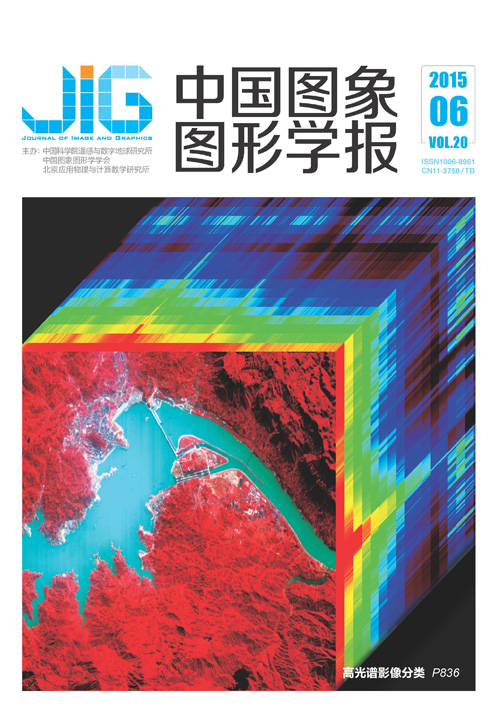
结合手指检测和HOG特征的分层静态手势识别
摘 要
目的 基于手势的交互方式在人机交互中发挥着越来越重要的作用,手势识别是大多数手势交互系统的核心技术.当手势种类较多时,目前已有的大多数手势识别方法往往无法获得足够高的识别率.为此,提出了一种结合手指检测和梯度方向直方图(HOG)特征的分层静态手势识别方法.方法 提出一种基于形态学操作的手指检测算法作为手势识别方法的基础.首先由肤色模型从输入图像中提取出手部区域,然后利用手指检测算法识别出手势包含的手指个数,并根据手指个数从事先训练好的支持向量机分类器集合中选取一个,最后提取手部区域的HOG特征,并利用选择好的分类器完成识别任务.结果 对25种常用手势进行了识别实验,将本文方法与单独使用HOG特征的方法进行对比.本文方法可以将传统HOG方法的识别率提高20%左右.结论 基于手指个数的分层识别策略可以有效地解决传统单层识别方法在手势种类较多时识别率不高的问题.在手部区域能被成功检测的情况下,提出的结合手指检测和HOG特征的方法可以取得较理想的手势识别结果,且能达到实时性要求.
关键词
Hierarchical static hand gesture recognition by combining finger detection and HOG features
Liu Shuping1, Liu Yu1, Yu Jun1, Wang Zengfu1,2(1.Department of Automation, University of Science and Technology of China, Hefei 230027, China;2.Institute of Intelligent Machines, Chinese Academy of Sciences, Hefei 230031, China) Abstract
Objective Hand gestures have recently been regarded as an important communication modality in human-computer interaction. These gestures are considerably advantageous over traditional interfaces such as the keyboard and mouse given their convenience and naturalness. Hand gesture interfaces have been successfully employed in many areas over the past 20 years, including robotics, sign language communication, clinical medicine, and the entertainment industry. Recognition is the key technique in most interaction systems based on hand gestures. Such recognition can be grouped into two categories: dynamic and static hand gesture recognition. Most existing methods for static hand gesture recognition usually perform poorly given the large number of hand gesture categories. In this study, we propose a hierarchical method of static hand gesture recognition that combines finger detection and histogram of oriented gradient (HOG) features to overcome this limitation. Method A hierarchical strategy is designed based on the number of outstretched fingers to solve the “large-category” problem described above. The basic idea is as follows: Entire categories of gestures are divided into several subsets according to the number of outstretched fingers. This number is first recognized by a certain finger detection method as an input gesture. Then, we derive the appropriate gesture from the subset that contains the gestures featuring the given number of fingers via a certain feature extraction approach. Thus, the recognition problem is solved in two stages. Following the first finger-based stage, the number of categories that must be addressed by the second layer decreases significantly. To achieve this target, we propose a new finger detection method based on morphological operations. The proposed method consists of the following steps. First, the hand region is detected with a skin color model. Then, the number of outstretched fingers is identified by the finger detection method. Accordingly, a support vector machine classifier is selected from a set of pre-classified classifiers. Finally, we calculate the HOG feature of the input gesture, which is then inputted into the selected classifier to obtain a result. Result In our experiments, 25 popular static gestures are tested to verify the effectiveness of the proposed recognition method. The one-stage HOG-based recognition method is mainly used for comparison. Experimental results demonstrate that the proposed method can improve the recognition accuracy of the conventional HOG-based method by approximately 20%.Conclusion This study makes three main contributions to literature. First, we present a new finger detection method that can accurately determine finger position and identify the number of outstretched fingers. Second, we design a finger-based hierarchical recognition strategy that can effectively overcome the “large-category” limitation for conventional one-stage recognition methods. Third, we propose a two-stage method of static hand gesture recognition that combines finger detection and HOG features. When hand regions can be detected effectively, the proposed method can perform satisfactorily with real-time efficiency. In the future, we will design a practical system for hand gesture recognition that employs a robust hand detection approach. Furthermore, the presented finger detection method can be used to normalize rotations as necessary.
Keywords
human-computer interaction static hand gesture recognition hierarchical strategy HOG features support vector machine
|



 中国图象图形学报 │ 京ICP备05080539号-4 │ 本系统由
中国图象图形学报 │ 京ICP备05080539号-4 │ 本系统由